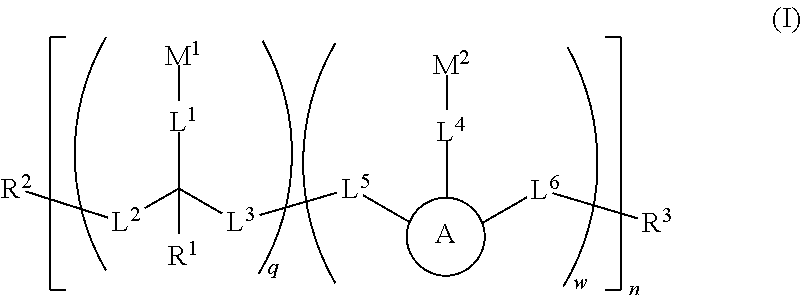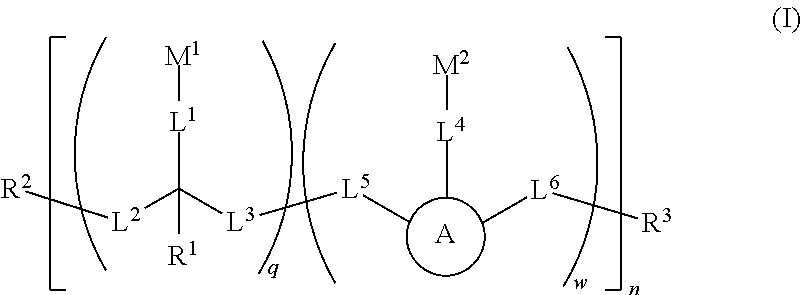Water soluble fluorescent or colored dyes and methods for their use
a fluorescent or colored dye and water-soluble technology, applied in the field of fluorescent or colored dyes, can solve the problems that perylene and related chromophores have seen limited use as biomolecular probes, and achieve the effect of being readily observed
- Summary
- Abstract
- Description
- Claims
- Application Information
AI Technical Summary
Benefits of technology
Problems solved by technology
Method used
Image
Examples
example 1
Synthesis of Phosphoramidite Dye Monomers
[0325]
1-O-(4,4′-dimethoxytrityl-2-methylene-1,3-propanediol (1)
[0326]Into a dry 500 mL round bottom flask was put a stir bar. After flushing with nitrogen, dry pyridine (240 mL) was added, and the flask was cooled in an ice bath for 15 minutes. Upon cooling DMTrCl (7.65 g, 22.5 mmol) was added after which the flask was stirred overnight in a refrigerator at 4° C. under a nitrogen atmosphere. Several drops of methanol were then added and the reaction was concentrated in vacuo to a viscous gum. The resulting gum was dissolved in EtOAc (200 mL) and washed with NaHCO3 (250 mL) and sat. NaCl (250 mL). The organic layer was dried over Na2SO4 and concentrated in vacuo to a viscous gum. The isolated crude product wash then purified by silica gel column chromatography eluting with a gradient of EtOAc:hexanes (25:75 v / v)-(1:1 v / v) to give 1 as a clear gum (5.21 g, 60%). 1H NMR was recorded and found to be consistent with the structure of compound 1.
1-O...
example 2
Synthesis of Perylene Carbodiimide Dye Monomer
[0330]
N-(2,3-propanediol) perylenemonoimide (4)
[0331]Into a dry 200 mL round bottom flask fitted with a condenser was put a stir bar and perylene monoanhydride1 (1.83 g, 5.67 mmol). After adding 3-amino-1,2-propanediol (1.1 g, 2.1 mmol) and imidazole (14.3 g, 0.21 mol), the vessel was heated to 140° C. in an oil bath for 15 hours. The reaction was allowed to cool to room temperature and then 10% HCl was added (500 mL). The resulting deep red precipitate was collected by filtration, washed well with water and dried at 180° C. for several hours to yield 4 as a deep red solid (1.95 g, 86%).
N-(3-O-(4,4′-dimethoxytrityl-2-hydroxypropane) perylenemonoimide (5)
[0332]Into a dry 200 mL round bottom flask was put a stir bar. After purging the flask with nitrogen, dry pyridine (120 mL), compound 4 (0.44 g, 1.1 mmol), and dimethoxytritylchloride (0.45 g, 1.3 mmol) were all added, and the reaction was allowed to stir at room temperature for 48 hours....
example 3
Synthesis of Oligomer Dyes
[0334]Oligomer dyes were synthesized on an Applied Biosystems 394 DNA / RNA synthesizer or on GE AKTÄ 10 OligoPilot on either 1 μmol or 10 μmol scales and possessed a 3′-phosphate group. Dyes were synthesized directly on CPG beads or on polystyrene solid support. The dyes were synthesized in the 3′ to 5′ direction by standard solid phase DNA methods. Coupling methods employed standard β-cyanoethyl phosphoramidite chemistry conditions. All phosphoramidite monomers were dissolved in acetonitrile / dichloromethane (0.1 M solutions), and were added in successive order using the following synthesis cycles: 1) removal of the 5′-dimethoxytrityl protecting group with dichloroacetic acid in toluene, 2) coupling of the next phosphoramidite with activator reagent in acetonitrile, 3) oxidation with iodine / pyridine / water, and 4) capping with acetic anhydride / 1-methylimidizole / acetonitrile. The synthesis cycle was repeated until the 5′ Oligofloroside was assembled. At the en...
PUM
| Property | Measurement | Unit |
|---|---|---|
| particle size | aaaaa | aaaaa |
| particle size | aaaaa | aaaaa |
| v/v | aaaaa | aaaaa |
Abstract
Description
Claims
Application Information
 Login to View More
Login to View More - R&D
- Intellectual Property
- Life Sciences
- Materials
- Tech Scout
- Unparalleled Data Quality
- Higher Quality Content
- 60% Fewer Hallucinations
Browse by: Latest US Patents, China's latest patents, Technical Efficacy Thesaurus, Application Domain, Technology Topic, Popular Technical Reports.
© 2025 PatSnap. All rights reserved.Legal|Privacy policy|Modern Slavery Act Transparency Statement|Sitemap|About US| Contact US: help@patsnap.com



